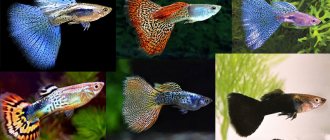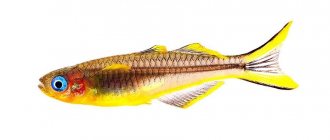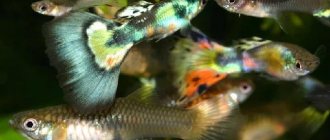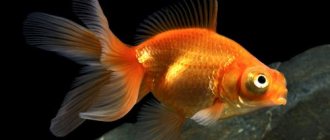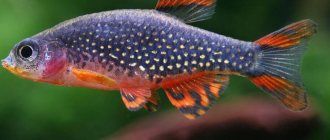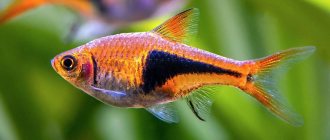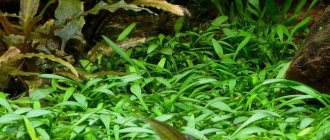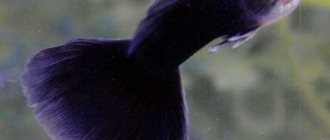Small, peaceful, viviparous guppies, which belong to the Poeciliaceae family, are among the most common and popular aquarium inhabitants. It is useful for novice aquarists to gain experience by caring for these unpretentious colorful residents.
| Full name | Guppy Guppy |
| Kinds | 4 groups: ● regular guppies; ● Endler; ● Micropecilium ● Swamp guppies. |
| Color | Yellow-golden, blue or green, red and white, orange and black. |
| Water | Acidity 6.5-8.5. Hardness 25. Temperature from 22 to 26 C. |
| Feed | They give you live ones - coretra, Cyclops crustaceans, bloodworms, Artemia nuplius. Seafood - squid, sea fish. Meat products include pieces of beef, heart, liver and lungs. Ready-made dry: Tetru, Serу, JBL and Zoomir. |
| Compatibility | With corydoras, neons, bots, aquarium catfish and other peaceful neighbors. |
| Lifespan | Up to 4 years |
History of appearance
We learned about guppies thanks to Robert John Lechmere Guppy. The scientist spent a long time observing the small inhabitants of the upper reaches of the St. Anne River on the island of Trinidad, near the Orinoco delta. In 1866, he caught a group of fish and brought them for a report to the English Royal Society. The journey lasted 4 weeks and the little passengers reached the place without any problems.
The learned men of the Society, having listened to the absurd, in their opinion, message about fish in which live young are born, and do not emerge from eggs, ridiculed Lechmere. The English priest Guppy isolated his find into a new genus Girardinus, and named the fish after their own name “Guppy”.
After some time, they found out that 7 years ago these fish had already been described by another scientist. Following the rules of scientific priority, the fish were given the name Lebistes reticulatus. 1963 - the return of the previous name. People are used to calling colorful fish guppies.
Appearance
The body length of elongated small fish is 4-7 cm; in females it is longer and larger than in males. But male guppies have large and bright fins. The guppy's skin is covered with diamond-shaped scales in a mesh pattern. These fish are representatives of carp-toothed fish, so the lower and upper jaws are armed with teeth.
The color of natural individuals is modest: the body is gray and there are small, although originally located, spots on the tail. This coloring camouflages the fish in algae thickets. At home in aquariums live single-colored, spotted, metallic and other colored guppies of selected forms and artificially bred ones.
Where do they live in nature?
Small and nimble fish come from South America. Unpretentious, with a high survival rate, guppies have easily spread throughout the waters of the world. Flowing clear water of lakes, rivers and canals, sometimes the coastal brackish waters of Barbados, Trinidad and Tobago, the northern valleys of the Amazon, Northern Brazil, Guiana, Venezuela are home to guppies.
Feral schools (10-12 fish each) appeared in lakes near Moscow, in the Moscow River, where hot water is discharged. Also, in areas where warm water is discharged, guppies are found in Yaroslavl, Tver, Nizhny Novgorod and Rybinsk. The geese also loved settling ponds.
Feeding on worms, larvae, bloodworms and malarial mosquitoes, the fish settle where there is a lot of this food. In some places, with an abundance of blood-sucking insects, guppies are specially released into warm bodies of water.
Types of guppies
Guppy are divided into 8 popular groups: regular guppies, Endler's group with 2 populations - red and green, and Micropecilia groups, represented by five species of guppies, each with 2 colored populations. Every year, as a result of selection, species are replenished with new specimens.
Do not confuse the types of guppies with the species diversity of breeds.
Ordinary natural look
The fish were brought to countries where many malaria-carrying mosquitoes bred. The species includes more than 60 breeds obtained by breeders.
Endler
Wild specimens of this group are gray and all its shades. In nature, it inhabits coastal lagoons in Venezuela. The body length of females is no more than 35 mm, the length of males is 1 cm less. It is recommended to keep such short ones in a nano aquarium. The coloring of males is presented in many variations, while females look too modest. The species is distinguished by black spots scattered randomly and orange luminous lines along the body. There are two populations: green and red fish. Suitable for care for inexperienced aquarists.
The species of guppies include:
- Santa Maria with a dark blue back and red belly, she is also called the bleeding heart. The breed was developed in Japan and is rare in other places;
- also from Japan brilliant Blue neons, sometimes with small red and dark spots;
- Black stripe - a fish with original black strokes or spots;
- Blue Star, Blue Snake and other attractive fish of this species.
Micropecilium
These are the closest relatives of Endler's group. Varieties of guppies of this species include Brunner's micropoecillium and dwarf species.
Swamp Guppy
In another way, this sought-after and rare species is called Pict micropecilia. The small and streamlined fish have silvery-green shades with yellow, blue, black and other spots. There are red and red-orange representatives of this species. Swamp guppies are demanding in terms of maintenance: one individual needs 10 liters of alkaline salted water, bright lighting and a lot of plants in the aquarium.
Germanic
Suitable for home breeding and aquarium decoration. The scales have a bluish tint, a golden tail fin, the body is white or one part is colored. The color of the head is yellow or white.
Compatibility with other fish
Peace-loving and non-conflict guppies get along best with close relatives from the poeciliaceae family. Guppies are defenseless against other fish, and no matter who you place them with, arrange shelters - dense bushes of plants.
The table shows the compatibility of guppies with other fish.
| Compatible |
|
| Limited compatibility |
|
| Not compatible |
|
When choosing neighbors, also take into account the similarity of living conditions, feeding and dimensions of the aquarium. Introduce the fish at the same time, this will reduce the risk of conflicts over territory and food.
Guppy breeds
The different colors of guppies of the same species and rapid reproduction without problems have helped to develop new breeds with incredible combinations of color and pattern. The emerging breed is named by paying attention to the tail fin (shade), the color of the fish, as well as the fins - size, shape and color.
Popular breeds of aquarium guppy fish:
| Name | Body color | Tail and fin color |
| The Spaniards are a variety of the Carpet Guppies breed. | Black with dark pattern | Yellow tail with red edge |
| "Snake skin" is called the filigree guppy, and is classified as a cobra guppy. | Along the body there is a pattern of rosette spots in gold, metallic, black and orange. | The tail is also patterned. |
| Berlin guppies for decorative aquariums | Half black. | Red fins. |
| Guppies Berliners | The color of the scales is blue, blue turquoise, dark purple. The head is white. | The tail is white, the dorsal fin is orange or fiery in color. |
| Guppy mix | Neon or greenish blotches | |
| Panda guppy is a prolific breed | Males have light spots on the sides and a black and blue neon body. | Males have light spots on the sides and a black and blue neon body. With black fins on the chest |
Carpet
Multicolor Dianthus
Varieties include Guppy Dianthus, brown or yellow-orange in color, and Velvet.
Red Moscow
Red Blonde
This group includes red guppies with variable patterns. These are: elephant ears with fluffy pectoral fins, often dark in color, red blond guppy and other varieties.
Pearlescent white
With white scales of pearlescent tint. Some fish have a dark front part of their head.
Half black
Another name is leopard guppies. On the black body of males there are spots like topazes. The color of the fins is graphite. Tail and dorsal fin with silver ornamentation. Varieties of semi-black guppies: blue type, white (Canadian). Red-tailed Berliner guppies are considered a resilient breed.
Sunset
This group is also called Pecilia solar or “sunset”. The Sunset Guppy is a selective breed. The body is red or orange with a smooth color transition.
Mesh
The fish are gray in color with silvery small patterns that look like a net.
Reds
Red Dragon Royal Guppy
This group includes all red guppies, but with variable patterns. This includes red dragon guppies, red mosaic, red platinum and other fish with a similar color.
Black
Black Prince
The breed of black guppies includes fish of the corresponding color and name: black prince, black Moscow, black tuxedo. It is difficult to maintain the black color in fish of this breed.
Blue
Breed Blue Guppies
These guppies lack yellow and red pigment, but red spots and yellow fins are sometimes found.
Varieties of guppies of this breed are blue and blue in color, which are called: blue peacock, blue diamond and other corresponding names.
Green
This includes all green guppies. The Moscow Blue-Green from this group has unstable breed purity.
Yellow
Yellow Blonde
This group includes yellow guppies of various shades, but the abdomen is light, almost white. For females - the predominant color. Often the yellow color replaces the planned red or green color.
White
White guppies were obtained by crossing fish with light and blue colors.
Cobra
Green cobra guppy
There are fish in red, green, yellow, blue or combinations thereof. The back of the cobra guppy's body is covered with prominent vertical stripes and specks. There are specks and spots along the veil tail. Among the varieties, the blue cobra guppy and the golden cobra guppy are attractive.
Orange
The color is bright orange. The scales are similar in color to mosaics.
Neon
Blue neon guppy
Guppy with a delicate sky-blue, slightly glowing color.
Tuxedo tuxedo
The breed is distinguished by its light upper body and dark belly. Sometimes the top is dark and the bottom is light, or the front part of the body is light and the back is darker. Many color combination options. The color of black and white guppies is compared to a tuxedo, but it is rare to maintain the purity of the tuxedo guppy breed.
Classification according to the shape of the tail and fins
The caudal fin is also used to determine the resistant varieties of guppies, noted in the table:
| Breed | Description of fins |
| Skirted Fantails | The tail is half the length of the body, in the form of an open fan at 75-90 degrees. Sometimes this fin looks like a skirt. The back is rounded and convex. |
| Fork | The original forked tail, like a fork with two prongs. The dorsal fin is curved with a long, sharp tip. |
| Flagtails | Long rectangular tail with a rounded edge. There is a narrow fin on the back, one end of which is pointed. |
| Spinetails | The tail is wide and round at the base. As it stretches out, it narrows and becomes like a needle. The thin, high dorsal fin also has a pointed end. |
| Speartails | The tail of these guppies is compared to a sharp spear, 8 body parts long and 6 wide. The high curved dorsal fin has a pointed end. |
| Triangel | This group is also called circumcised fantails. The long triangular tail, with sharp corners, does not open much. The base of the dorsal fin is narrow, rising higher, it becomes wider. |
| Round-tailed | The large, rounded tail is fused with an equally large, rounded dorsal fin. |
Maintenance and care at home
Guppies, although considered hardy fish, require proper care. The size of the aquarium, water, plants in the water, food, neighbors and other factors are taken into account. To begin with, you should get 10 fish in pairs, preferably of the same breed and in a spacious aquarium.
Which aquarium to choose
If there are few fish, 8-10 specimens, a 50-liter container with a lid will do. One fish will need 2 liters of water. Cover the bottom with dark soil - coarse calcined sand or pebbles. Pour water 6 cm below the top edge so that the guppies do not jump out.
Equipment (filter, heater, light, compressor)
Aquariums are usually equipped with devices to create comfortable conditions for fish:
- equipped with internal or external filters for purification and simultaneous aeration of water;
- a lot of light helps the frogs look brighter; to lengthen the daylight hours, the aquarium is equipped with special warm-spectrum lamps;
- covered aquariums are forcibly aerated using a compressor, which enriches the water with dissolved oxygen;
- To maintain the desired temperature, you will need a thermostat with a power of 1.5 watts per liter of water.
Decor and plants
Decorative elements are installed without sharp corners and edges, otherwise the males will injure the fluttering tails and fins. Many living plants are planted to supply the water with oxygen. Most often these are small-leaved plants of hornwort, ludwigia, cabomba and other species.
Water requirements
Only clean water without impurities is required. For weekly topping, it needs to be settled. The filter is installed so that the flow rate is low. Guppies are heat-loving fish, so the comfortable temperature for them is 24-26 degrees, but they easily adapt to the range of 18-30 degrees.
Guppy fish care
If you watch the video at the end of the article - “All about guppies”, it will tell you in detail how to properly care for small fish. It is not difficult. The main thing is proper feeding, regular cleaning of the aquarium and partial replacement of water, otherwise the veil fins will look tattered.
The fry are kept in a separate small aquarium for the first 1.5 weeks. At 1 month, boys and girls are separated into different containers.
Curious! Guppies give birth to already developed fry, capable of feeding on small food.
Feeding
Guppies are omnivorous aquarium fish; they eat small animal and plant foods, which consist of protozoan microorganisms and rotifers. Feed colorful fish 1-2 times a day every 30 minutes. after the lamp is turned on. Enough food is poured in so that the guppies eat it within 2-3 minutes. What remains needs to be removed. Fasting days are arranged twice a week. The fry are fed 4 times.
Guppy breeding and reproduction
The female carries the cubs for 3-4.5 weeks. The duration depends on the water temperature. Then the fry are born - sometimes 200 in old females, fewer in young ones, sometimes only 1. And they come out in groups after 1-1.5 months. To do this, the female mates only once, and retains the seed even for up to a year. After giving birth, the female moves to another aquarium.
To breed a new breed, they take only virgin females that grew up in a separate aquarium.
At one month, sex differences are already visible, so catching them will not be difficult. Guppies are capable of bearing offspring at 3.5-5 months of age.
Compatibility with other aquarium fish
Small guppies are non-conflict fish, calm and friendly, and easily get along with other peaceful inhabitants of the aquarium. They swim in schools, occupying the middle and upper layers of water. You should not live with barbs and rainbows, which are irritated by the veiled tails of guppies. Cichlids will simply eat small fish.
Allowed to accommodate:
- with corridors;
- neon;
- boots;
- with aquarium catfish;
- with zebrafish;
- rasborami;
- mollies;
- tetras;
- with flashlights and other peaceful fish.
The main thing is not to overpopulate the aquarium, and choose fish with the same living conditions.
Lifespan
Domestic guppies live up to 2.5-3 years, sometimes even up to 5. The main factor in increasing lifespan is water temperature. Too warm water is more likely to age the body; in cold water, on the contrary, it increases age. Older guppies get sick more often. This also leads to early death.
Differences between male and female
Photo of male and female guppies
These fish have pronounced sexual dimorphism. Wild females have gray and colorless fins, and the body color is gray-green, bluish or olive.
If you look at their behavior, the females behave calmly, even phlegmatically. Guppies are playful and active boys.
Body Shape
Males are elongated, with a flattened and slender body. In females, the sides of the rear part of the body are more flattened.
Body size
In guppies, the size of males and females varies. The body of females is large, thick, barrel-like. 3-6 cm in length, there are specimens up to 7 cm. Males grow up to 2-3.5 cm,
Color
The body and fins of males, on which the original pattern stands out, are brightly and catchily colored. The breed affects whether it is monochromatic or multicolored. The color of females is inexpressive gray-brown shades.
Pregnancy spot
Guppies with a pregnancy spot
Before giving birth, on the female's enlarged square abdomen, the spot next to the anal fin becomes darker and larger. This spot, also called the birth spot, appears in female fry at the age of 1 month. In guppies with light colors, the difference is not always the same.
Structure of the dorsal fin
In females this fin is short and faintly colored. Males sport elongated and elongated, brightly colored, often fluttering fins.
Features of the caudal fin
Only male guppies boast veil-colored fins. Females got undeveloped tails; a simple and rounded shape of a greenish, yellow or bluish tint is more common.
Anal fin
Males are distinguished by a modified anal fin, the gonopodium, the main sign of maleness. This fin is phallic in shape and helps males fertilize females.
Health
Under the right conditions, responsible care and a balanced diet, guppies are healthy pets that do not cause any trouble. However, with serious lapses on the part of the owner, even robust guppies can get sick. The most common diseases and symptoms are:
- Tail splitting (due to poor water quality, injury or fin rot);
- Curved spine in guppies (congenital anomaly, trauma, overeating or dangerous fish tuberculosis);
- Semolina and other infectious diseases (viral, fungal, bacterial infection or poor water quality).
Based on the above, guppies are a strong, hardy and active breed that requires standard care. In which the fish’s immune system will work correctly, and therefore reflect negative factors.
It should be remembered that selective forms of guppies, obtained through complex inbreeding and other tricks, have weaker immunity in relation to “mutts”.
Diseases
Guppy fish suffer from the same diseases that affect tropical fish. Therefore, the stamina of goosebumps does not always save. Sometimes a severe infection occurs or the fish is injured. Treating aquarium inhabitants is a complex matter.
Sick people are often destroyed, after which the aquarium must be disinfected, and proper care must not be forgotten
Tail destruction
The condition of the tail can be spoiled by:
- fin rot, which destroys the interray tissue, is more dangerous for scarf guppies;
- red scab, marked by a bright red coating that affects the tip of the tail, then slowly destroys the entire caudal fin, more often appears in males;
- splitting, when the fin splits longitudinally, threatens veiled males.
Hump formation
If the fish are old, curvature is normal; the appearance of a hump in fertile guppies is a disease caused by:
- injury;
- scoliosis;
- sudden changes in the volume of the holding tank, overcrowding;
- overfeeding;
- the appearance of tuberculosis.
Oxygen starvation
The state of hypoxia is considered fatal for fish.
Symptoms: Breathing rapidly or with difficulty, hovering or swimming close to the surface with the mouth open, noticeably swollen gills and lack of coordination. In severe cases, the fish lie on the bottom. The color sometimes becomes brighter, the fish's eyes become glassy and do not move.
Inactivity
If the guppy begins to move little and does not want to eat food, the body becomes covered with a mucous coating, which tightens the gill slits and sticks the fins together - this is a manifestation of costosis. In addition, it is difficult for the fish to breathe, and the body becomes covered with bluish spots.
Behavior
These are very peaceful fish; conflicts between guppies and other species can be counted on one hand. The main reasons for conflicts between guppies are the fight for a female or poor living conditions. They almost never act as an aggressor with other fish; however, other moderately aggressive fish often attack guppies. Therefore, it is important to keep them in an aquarium with plenty of plants or other cover. On the other hand, guppies can be bred as live food for larger fish.
Approximately how much do they cost?
They buy guppy fish in pet stores or markets, where they offer a large selection of breeds. When buying, it is worth remembering that if you take 2 males, then you will need to take 4 females. The cost is influenced by the popularity and rarity of the breed, as well as the age and size of the specimens. The average price of a guppy is 90-110 rubles.
A fascinating sight - bright and colorful small fish with fluttering tails and fins scurrying around in the aquarium. Dear readers who want to have such beauty at home, please note that you should start with guppies. Care is clear and uncomplicated.
And what happens, we hope that you will send comments.
Owner reviews
Guppy fish are distinguished by their unpretentiousness, so keeping them can be accessible even to novice aquarists. The fish is small, but quite attractive in beauty and does not require special conditions. Despite this fact, many experienced owners of these fish do not recommend that novice hobbyists start keeping bright and beautiful fish that have long and uniform fins.
It is important to know! Such aquarium fish are characterized by rather weak immunity, which requires special attention to the conditions of their keeping.
Compared to selected species, simple varieties of Guppy fish are more resistant to living conditions, and therefore can please their owners for a long period. At the same time, it does not create any problems at the stage of keeping them in an artificial environment.
